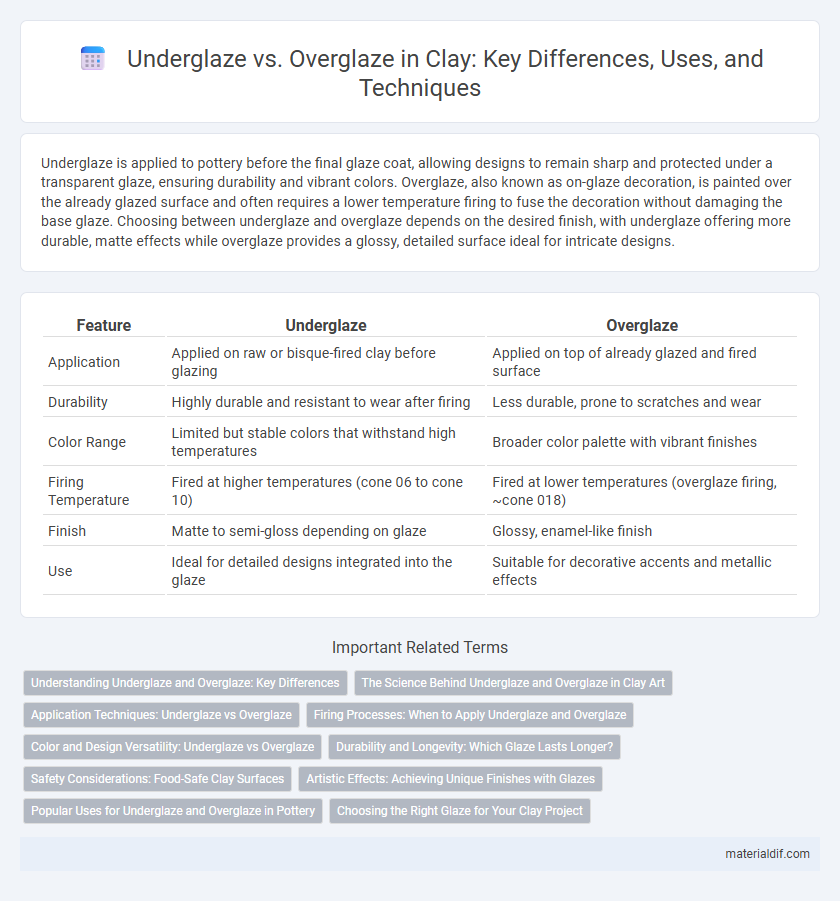Underglaze is applied to pottery before the final glaze coat, allowing designs to remain sharp and protected under a transparent glaze, ensuring durability and vibrant colors. Overglaze, also known as on-glaze decoration, is painted over the already glazed surface and often requires a lower temperature firing to fuse the decoration without damaging the base glaze. Choosing between underglaze and overglaze depends on the desired finish, with underglaze offering more durable, matte effects while overglaze provides a glossy, detailed surface ideal for intricate designs.
Table of Comparison
| Feature | Underglaze | Overglaze |
|---|---|---|
| Application | Applied on raw or bisque-fired clay before glazing | Applied on top of already glazed and fired surface |
| Durability | Highly durable and resistant to wear after firing | Less durable, prone to scratches and wear |
| Color Range | Limited but stable colors that withstand high temperatures | Broader color palette with vibrant finishes |
| Firing Temperature | Fired at higher temperatures (cone 06 to cone 10) | Fired at lower temperatures (overglaze firing, ~cone 018) |
| Finish | Matte to semi-gloss depending on glaze | Glossy, enamel-like finish |
| Use | Ideal for detailed designs integrated into the glaze | Suitable for decorative accents and metallic effects |
Understanding Underglaze and Overglaze: Key Differences
Underglaze is applied to pottery before the final glaze coating and firing, allowing for intricate designs that remain vibrant under a glossy surface. Overglaze, also known as on-glaze, is painted on top of an already glazed and fired piece, then fired again at a lower temperature to set the decoration. The key difference lies in the application timing and firing process, which affect the durability and visual texture of the ceramic artwork.
The Science Behind Underglaze and Overglaze in Clay Art
Underglaze involves applying colored decoration directly onto raw or bisque-fired clay, where pigments fuse with the clay body during the final glaze firing, ensuring durability and vibrant colors. Overglaze, also known as on-glaze, is applied on top of an already glazed and fired surface, requiring a lower temperature firing to fix the design, often allowing for more intricate detail but less durability. The chemical interaction between the clay, pigments, and firing temperature fundamentally differentiates the two techniques, impacting the final appearance and longevity of the artwork.
Application Techniques: Underglaze vs Overglaze
Underglaze is applied directly onto raw or bisque-fired clay, allowing for intricate designs that resist smudging during glazing and firing processes. Overglaze involves painting on an already glazed and fired surface, requiring a secondary firing at lower temperatures to adhere the decoration without damaging the glaze. Techniques for underglaze focus on precision before final glazing, while overglaze demands careful layering to enhance color vibrancy and surface texture.
Firing Processes: When to Apply Underglaze and Overglaze
Underglaze is applied before the first firing or bisque firing, allowing it to fuse with the clay body and create durable, vibrant designs that withstand high temperatures. Overglaze, also called onglaze, is applied after the bisque firing and often after the glaze firing, requiring a lower-temperature firing to fix the decoration without melting the glaze beneath. Understanding the firing schedule is essential for choosing between underglaze and overglaze to ensure optimal adhesion, color stability, and surface finish in ceramic artwork.
Color and Design Versatility: Underglaze vs Overglaze
Underglaze offers superior color stability during firing, allowing for detailed designs that remain vibrant and sharp beneath a transparent glaze. Overglaze provides a broader palette of colors and metallic finishes, enabling intricate surface decorations applied after the initial firing. The choice between underglaze and overglaze depends on the desired durability and complexity of the color and design in ceramic art.
Durability and Longevity: Which Glaze Lasts Longer?
Underglaze offers superior durability due to its application beneath the final transparent glaze, protecting decoration from wear and fading over time. Overglaze, applied on top of the glaze, is more susceptible to chipping and abrasion, reducing its longevity. For lasting results on ceramic pieces, underglaze remains the preferred choice for maintaining vibrant designs through prolonged use.
Safety Considerations: Food-Safe Clay Surfaces
Underglaze is generally safer for food-safe clay surfaces because it is applied beneath a clear glaze, sealing pigments and preventing direct contact with food, while overglaze sits on top and may contain materials that can leach toxins. Certified food-safe underglazes comply with ASTM C-738-14 standards, ensuring non-toxicity and durability after firing at recommended temperatures. Proper kiln firing at appropriate temperatures between cone 06 to cone 10 is critical to vitrify the glaze, further securing the food-safe integrity of ceramic dinnerware.
Artistic Effects: Achieving Unique Finishes with Glazes
Underglaze offers precise control for intricate designs with its matte or low-gloss finish, allowing detailed patterns to remain sharp after firing. Overglaze creates vibrant, glossy surfaces by applying translucent colors atop a fired piece, enhancing depth and richness. Combining both techniques enables artists to achieve distinctive textures and layered effects, expanding creative possibilities in ceramic artistry.
Popular Uses for Underglaze and Overglaze in Pottery
Underglaze is popular for detailed designs and intricate patterns applied before the final glaze firing, offering durability and resistance to wear. Overglaze is commonly used for decorative accents such as metallic finishes, decals, and vibrant colors applied after the glaze firing and then fired again at lower temperatures. Potters often choose underglaze for functional ware due to its permanence, while overglaze enhances ornamental pieces with glossy, vivid embellishments.
Choosing the Right Glaze for Your Clay Project
Choosing the right glaze for your clay project depends on the desired finish and firing process, as underglaze offers precise designs with matte or satin textures and can be applied before the final clear glaze. Overglaze provides a glossy, durable coating and is typically applied after the initial glaze firing, enhancing color vibrancy and surface protection. Understanding the differences between underglaze and overglaze ensures optimal aesthetics and durability for ceramics.
Underglaze vs Overglaze Infographic

 materialdif.com
materialdif.com